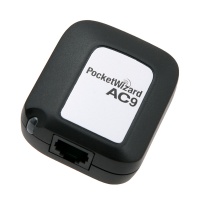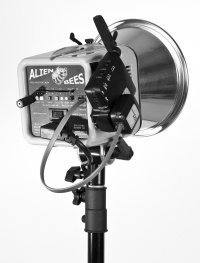Difference between revisions of "AC9 AlienBees Adapter"
| Line 207: | Line 207: | ||
| − | + | == Using an AC3 Zone Controller == | |
An AC3 ZoneController on your transmitting ControlTL® radio allows you to adjust the remote flash output power for up to 3 zones independently, in either Manual or Automatic modes. | An AC3 ZoneController on your transmitting ControlTL® radio allows you to adjust the remote flash output power for up to 3 zones independently, in either Manual or Automatic modes. | ||
Set the Zone Switch on your remote FlexTT5® equipped with an AC9 to Zone A, B, or C as desired. | Set the Zone Switch on your remote FlexTT5® equipped with an AC9 to Zone A, B, or C as desired. | ||
| − | + | === Manual Mode === | |
With an AC3 Zone Switch set to M (Manual), the AC3 Power Dial for that zone sets the absolute flash power output as shown in the table for Basic Power Control. Your camera’s FEC/EC, ISO, and aperture controls will not affect the flash output power levels for AC3 zones set to M. | With an AC3 Zone Switch set to M (Manual), the AC3 Power Dial for that zone sets the absolute flash power output as shown in the table for Basic Power Control. Your camera’s FEC/EC, ISO, and aperture controls will not affect the flash output power levels for AC3 zones set to M. | ||
| − | + | === Automatic Mode === | |
With an AC3 Zone Switch set to A (Automatic), Automatic PowerTracking using Center on ISO & Aperture with First Shot is engaged. See the Automatic PowerTracking section for more information. The AC3 Power Dial for a zone sets the flash power output level for that zone relative to the ControlTL center point. Your camera’s FEC control can be used to adjust flash output power level for all zones set to A (Auto). | With an AC3 Zone Switch set to A (Automatic), Automatic PowerTracking using Center on ISO & Aperture with First Shot is engaged. See the Automatic PowerTracking section for more information. The AC3 Power Dial for a zone sets the flash power output level for that zone relative to the ControlTL center point. Your camera’s FEC control can be used to adjust flash output power level for all zones set to A (Auto). | ||
| − | + | ==== Off ==== | |
an AC3 Zone Switch set to Ø (Off), flashes in that zone will not trigger. | an AC3 Zone Switch set to Ø (Off), flashes in that zone will not trigger. | ||
Revision as of 07:06, 30 August 2011
| Next recommended reading: MiniTT1 and FlexTT5 |
Adapter for Paul C. Buff lighting systems.
The AC9 AlienBees Adapter paired with a FlexTT5™ Transceiver enables remote power control of AlienBees or White Lightning flash. With a MiniTT1™ Transmitter or FlexTT5™ Transceiver on your camera, you can now adjust the power settings on your AlienBees or White Lightning flashes from the camera’s position. Add the AC3 ZoneController and you can control three different groups of lights in 1/3-stop increments with a six-stop range. Utilize PocketWizard’s unique features such as HyperSync™ and Optimized Rear Curtain Sync for maximum control of your lighting.
How to set up your AC9
Make sure all your radios are set to the same PocketWizard ControlTL channel. For more information on Channels, see our Channels wiki page.
1. Slide the AC9 onto your remote FlexTT5 and connect the REMOTE cable from the AC9 to the flash.
2. Turn on the flash first, then the remote FlexTT5 radio. If this order is reversed, the flash may not trigger properly. The AC9’s Status LED blinks green occasionally to indicate normal operation.
3. Turn on the modeling light and set it to Cycle or Ready mode as desired, and disable the optical slave by inserting a plug or adapter into the sync port. Power level will be set by the AC9.
4. Set up your camera and PocketWizard ControlTL transmitter.
5. Take pictures.
6. Adjust the Camera’s Flash Exposure Compensation (FEC) to adjust the output power of your remote flash. See the Camera FEC Range and Basic Power Control sections for more information on FEC.
Note: The AC9 overrides flash power output settings you make directly on your flash. If you wish to control the flash from its control panel, then you need to disconnect the REMOTE cord and connect a regular sync cord from the P2 port on your FlexTT5 to your flash.
Features
ControlTL
PocketWizard’s newest firmware platform taps into the camera’s digital communications to enable an entirely new level of remote flash capability through our proven radio system. ControlTL allows remote TTL systems as well as Manual Power Control. ControlTL firmware is configurable and upgradeable for “future-proof” continuous improvement.
Manual Power Control
Adjust the manual power settings of your remote AlienBees flash directly from a AC3 ZoneController, or master flash mounted on your on-camera MiniTT1 or FlexTT5. You can independently control the power output of up to three remote groups of lights (you can have as many lights in each group as you want) from full power down to the lowest setting through the user interface on the back of the master flash or with the dials of the AC3 ZoneController. Now you can work with total control with your remote lights, without leaving your shooting position.
PowerTracking
When engaged, any changes to aperture and ISO on your camera are automatically tracked by your remote flash output power to maintain the current exposure level. For example, if you open the aperture on your camera by one stop, then the power output level on your remote flash will decrease by one stop.
Basic Power Control
With only a MiniTT1® or FlexTT5® on your camera, your camera’s FEC (Flash Exposure Compensation) control will adjust your flash power output level for all your AC9-connected flashes as shown in the table below:
| AlienBees, White Lightning, Zeus Power Output Settings | ||
|---|---|---|
| Camera FEC/EC - or - AC3 Power Dial in Manual |
Most Models | White Lightning X1600, X2400 & X3200 Only; Low Range Mode |
| +3 | 1/1 | 1/4 |
| +2.7 | 1/2 + 0.7 | 1/8 + 0.7 |
| +2.3 | 1/2 + 0.3 | 1/8 + 0.3 |
| +2 | 1/2 | 1/8 |
| +1.7 | 1/4 + 0.7 | 1/16th + 0.7 |
| +1.3 | 1/4 + 0.3 | 1/16 + 0.3 |
| +1 | 1/4 | 1/16 |
| +0.7 | 1/8 + 0.7 | 1/32 + 0.7 |
| +0.3 | 1/8 +0.3 | 1/32 + 0.3 |
| 0 | 1/8 | 1/32 |
| -0.3 | 1/16 + 0.7 | 1/64 + 0.7 |
| -0.7 | 1/16 + 0.3 | 1/64 + 0.3 |
| -1 | 1/16 | 1/64 |
| -1.3 | 1/32 + 0.7 | 1/128 + 0.7 |
| -1.7 | 1/32 + 0.3 | 1/128 + 0.3 |
| -2 | 1/32 | 1/128 |
| -2.3 | 1/32 | 1/128 |
| -2.7 | 1/32 | 1/128 |
| -3 | 1/32 | 1/128 |
| Nikon Only |
| Canon Only |
FEC. For example, if your first picture was at ISO 200, and you adjusted ISO down to 100, your flash power level would be 1 stop brighter for all FEC settings. This operation assumes PowerTracking is set to Full Manual in the PocketWizard Utility which is the default.You can use any PocketWizard receiving radios together in the same exposure, including other ControlTL radios. Remember that studio and manual flash output will not be calculated as part of an E-TTL / i-TTL exposure. 00a
ControlTL® Center Point
The center point for all ControlTL operations, including Basic Power Control, PowerTracking, or when using an AC3 ZoneController, is 3 stops down from your flash’s maximum. For example, in Basic Power Control, this means 0 on your camera’s FEC equals 1/8 on your flash and FEC +3 equals 1/1 (full power). This setting may be customized using the PocketWizard Utility under the PowerTracking tab to place the center point anywhere within the flash’s 5 stop range.
Camera FEC Range and Basic Power Control
You can change the center point to better match your camera’s FEC range. Adjust the AC9 Flash Exposure Compensation control in the PocketWizard Utility for each FlexTT5 with ACP to better align your camera’s FEC with the flash’s 5 stop range. See the PocketWizard Utility FlexTT5® Receiver settings section for more information.
This setting must be configured on each receiving FlexTT5 radio. Adjusting it on a transmitting FlexTT5 has no effect on your remote flash’s power output level.
| Camera FEC Range | Maximum remote AC9 power level available using default settings | Minimum remote AC9 power level available using default settings | Set each AC9 FEC so camera maximum FEC equals flash maximum output power | Set each AC9 FEC so camera minimum FEC equals flash minimum output power |
| Canon +3/ -3 | 1/1 at FEC +3 | 1/32 at FEC -2 through -3 | 0 | 0 |
| Canon +2/ -2 | 1/2 at FEC +2 | 1/32 at FEC -2 | +1 | 0 |
| Nikon +1/ -3 | 1/4 at FEC +1 | 1/32 at FEC -2 through -3 | +2 | -1 |
Using an AC3 Zone Controller
An AC3 ZoneController on your transmitting ControlTL® radio allows you to adjust the remote flash output power for up to 3 zones independently, in either Manual or Automatic modes. Set the Zone Switch on your remote FlexTT5® equipped with an AC9 to Zone A, B, or C as desired.
Manual Mode
With an AC3 Zone Switch set to M (Manual), the AC3 Power Dial for that zone sets the absolute flash power output as shown in the table for Basic Power Control. Your camera’s FEC/EC, ISO, and aperture controls will not affect the flash output power levels for AC3 zones set to M.
Automatic Mode
With an AC3 Zone Switch set to A (Automatic), Automatic PowerTracking using Center on ISO & Aperture with First Shot is engaged. See the Automatic PowerTracking section for more information. The AC3 Power Dial for a zone sets the flash power output level for that zone relative to the ControlTL center point. Your camera’s FEC control can be used to adjust flash output power level for all zones set to A (Auto).
Off
an AC3 Zone Switch set to Ø (Off), flashes in that zone will not trigger.
Requirements
The FlexTT5 for Canon requires AC9-C / FlexTT5 for Nikon requires AC9-N.
The AC9 AlienBees Adapter requires a receiving FlexTT5, a transmitting PocketWizard ControlTL radio such as a MiniTT1 or FlexTT5, and a compatible Paul C. Buff flash with a REMOTE terminal.
Compatibility
| AC9 AlienBees Adapter Compatiblity | ||||
|---|---|---|---|---|
| AlienBees | White Lightning | Zeus | UltraZAP | Ultra |
| B400 | X800 | Z1250 | UZ800 | Ultra600 |
| B800 | X1600 | Z2500 | UZ1600 | Ultra1200 |
| B1600 | X2400 | Ultra1800 | ||
| ABR800 | X3200 | |||


